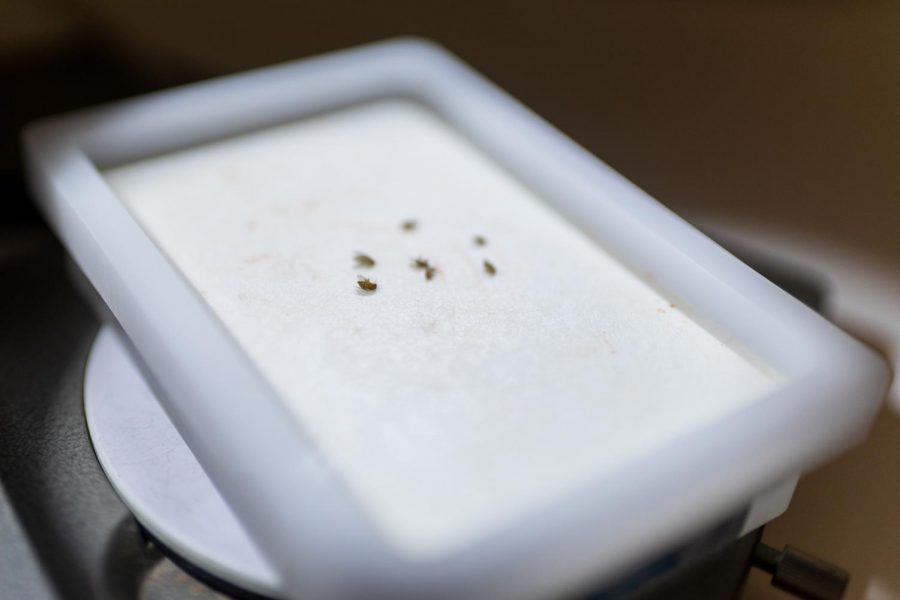In the Gortner Laboratory on the St. Paul campus, University of Minnesota graduate student Nate Feltman examines a fruit fly under a microscope. About three millimeters in diameter, the spotted wing drosophila has been wreaking havoc on many soft-skinned berries in almost all of the states in the U.S., including Minnesota.
With a taste for fruits like raspberries, strawberries, blueberries and cherries, the invasive species has hit Minnesota berry growers by storm in the peak of their harvest season since it was first observed in the U.S. in 2008. Laying eggs in ripening fruit, the flies make fruit spoil quicker and make it unmarketable for farmers.
A team of researchers at the University are looking for a way to introduce sterile male spotted wing drosophila flies into the population as a form of genetic pest control, helping farmers in a way that other pesticides and proactive measures have not.
In early November, assistant professor Mike Smanski published an article about a new breakthrough in this research, demonstrating for the first time this kind of genetic engineering was possible in the common fruit fly. This shows that researchers could engineer this work into spotted wing drosophila in the future.
The University’s Smanski Lab has also studied this technique in mosquitoes, zebra fish and carp, but never with this type of fruit fly, he said.
“These are all a new class of genetic pesticide, basically, that allow you to engineer the pest organism itself and convert that pest organism into the pesticide,” Smanski said.
Through this work the researchers can create a pest that is biologically the same, but when the females mate with these genetically modified males, they will not produce viable offspring, he said.
This sterile insect technique can be helpful not only in reducing the population of insects, but in reducing the impacts of insecticides on surrounding species and nearby ecosystems, said Feltman, a second-year biochemistry, molecular biology and biophysics graduate student.
As part of the second phase of the research, they will be doing lab tests on the genetically modified spotted wing drosophila, he said. The hope is that the genetic work will prevent the flies from producing offspring.
Over the past decade, researchers have placed traps to study the flies in various farms around the state, including The Berry Patch in Forest Lake, Minnesota.
Kevin Edberg, an owner of the farm, said he first saw the spotted wing drosophila about five or six years ago. His farm is primarily composed of raspberries, strawberries and blueberries that customers pick themselves. Since the flies have come in and made the fruit rot prematurely, he has lost the last week of his harvest season, which is generally one of the most profitable weeks of the year.
Edberg started putting up traps filled with apple cider vinegar to capture the flies and monitor when they come out. In early July, he would catch up to four flies per trap. As the season goes on however, he will catch almost 600 per trap.
“Of all the changes that I’ve seen, and all of the challenges that have evolved over the last 40 years, [the spotted wing drosophila is] the one that has been the biggest game changer in how we manage and grow,” he said.
Traditional avenues of pest management do not work either, he said, which makes it even harder to navigate how to stop them. And if they do not control it one year, they will come back worse the next.
Jerry Untiedt, owner of Untiedt’s Vegetable Farm Inc. in Waverly, Minnesota, is another berry farmer University researchers have been working with.
Because he uses a high tunnel — an unheated greenhouse — and sweeps, blows and vacuums the rows between his crops to get rid of rotting fruit that attracts the bugs, Untiedt said he has fared better than other farms in the industry. Anecdotally, Untiedt said that 40% to 50% of raspberry growers no longer grow raspberries because the pest management is too complicated and costly.
He said he is grateful for the University’s work because without their research, there would not be much known about the spotted wing drosophila.
“This is of utmost importance because most people don’t understand the biology of this fruit fly and what it could do to this industry,” Untiedt said. “If you’re not vigilant in your management, it can actually destroy your entire crop. … Literally, a plague to be reckoned with.”
Correction: A previous version of this story misstated the Smanski Lab’s progress with genetic engineering in some organisms.














